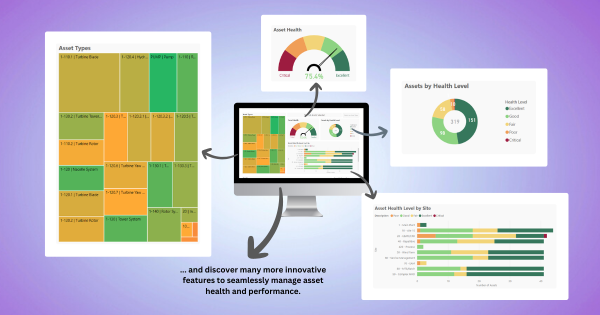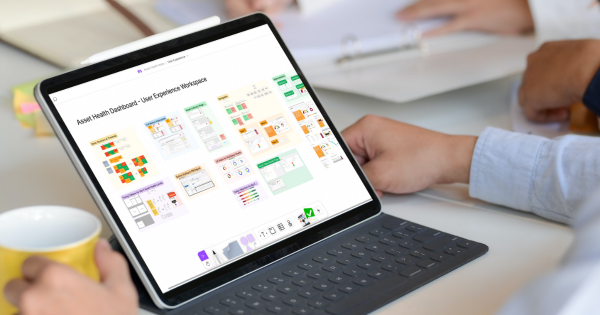The early days of enterprise software were marked by functionality taking precedence over user experience. However, users today expect intuitive, aesthetically pleasing, and efficient interfaces that simplify complex workflows.
As businesses realized this demand for user-friendly interfaces, the UX landscape in enterprise software started to shift. In response to this changing landscape, IFS has consistently adapted and evolved its UX design approach. One remarkable success story showcasing our commitment to user-centric design is the Asset Health Dashboard developed as a part of our Asset Performance Management (APM) capabilities.
The Asset Health Dashboard

In the realm of enterprise software, the Asset Health Dashboard transforms asset management with timely insights and actionable data. This tool empowers organizations to identify issues proactively, optimize maintenance schedules, and enhance asset performance. The dashboard serves as a valuable asset management solution, enabling organizations to make data-driven decisions with confidence.
Beyond its technical capabilities, the dashboard serves as a bridge between generations in the workforce. In many organizations, there is a demographic divide between long-serving asset managers accustomed to traditional desktop interfaces and younger technicians who prefer more graphical approaches. The dashboard spans these age ranges by enabling knowledge to flow seamlessly from experienced professionals to newcomers.
Benefits of the Asset Health Dashboard
- Asset Overview – Users can view the status of all assets in one consolidated view, streamlining monitoring and decision-making processes.
- Customizable Data View – Users can slice and dice asset-related data to suit their specific roles or objectives, whether it is for all assets, a specific site, or a particular asset type.
- Identify Underperforming Assets – Users can easily identify underperforming assets and take prompt appropriate actions.
- Customizable Indicators – Users can select indicators such as asset age and condition, determined by parameters including temperature, corrosion, operation time, vibration, etc.
- Strategic Insights – The dashboard empowers decision-makers to identify the right time and approach to repair or replace critical assets, thereby enabling informed decision-making and optimizing maintenance schedules.
- Historical Data – Users can track how the health of assets has changed over time, enabling proactive maintenance planning.

The Iterative Design Process
As the UX designer working on the Asset Health Dashboard, I led a comprehensive iterative design process to ensure the creation of a truly user-centric solution. I began with crafting a persona for the “Asset Manager” role where I delved into their daily experiences and challenges to gain invaluable insights into their needs and behaviors. Using this understanding, I mapped out their user journey, identifying key touchpoints and pain points along the way. From there, I worked on the user flows, ensuring that every interaction with the dashboard was intuitive and seamless. Collaboration was key in this process, as I facilitated workshops with Program Managers, Product Managers, Product Specialists, and Software Architects to brainstorm and ideate innovative solutions.

Translating these ideas into tangible designs, I sketched out concepts, created wireframes, and developed a clickable prototype that provided stakeholders with a clear visualization of the proposed solution. But the work didn’t stop there; I conducted 15 usability tests, gathering feedback from users to pinpoint areas for improvement. This feedback loop was integral to our iterative approach, ensuring that each iteration of the dashboard addressed user pain points and enhanced the overall user experience. Through this iterative journey, characterized by collaboration, creativity, and continuous improvement, we were able to deliver a final product that not only met but exceeded user expectations.
Global Recognition of the Asset Health Dashboard

The Asset Health Dashboard emerged as a standout feature, garnering significant attention at the IFS Sales Kick Off event held in London, UK, in both 2023 and 2024. As a key feature of our APM solution, it captivated the interest of over 1100 attendees, including industry experts, partners, and stakeholders. Showcasing its transformative capabilities, we demonstrated how the dashboard empowers Asset Managers with timely asset insights. Additionally, it was featured at the IFS Connect events in 2023 across various locations worldwide, including the USA, UK, Netherlands, Poland, France, Japan, Dubai, and Sweden. The positive reception and engagement from this global audience highlighted the significant value of user-centric design in enterprise software.

Moving forward, the Asset Health Dashboard will take center stage at the upcoming IFS Unleashed event in Orlando, Florida, set for October 14-18, 2024. Additionally, it will be featured at the forthcoming IFS Connect 2024 events in various locations, including England, France, Denmark, Australia, Saudi Arabia, Poland, Netherlands, and Turkey. These global showcases highlight the broad adoption and profound impact of the dashboard in empowering organizations worldwide.
The User-Driven Future of Enterprise Software
The Asset Health Dashboard is one example of how IFS is at the forefront of shaping the future of enterprise UX. Our commitment extends beyond merely keeping pace with industry trends; we lead the way by providing cutting-edge solutions that empower users. In my role as a Senior UX Designer at IFS, I am constantly pushing boundaries to innovate and prioritize user-centric design. Through the strategic integration of user feedback and the embrace of iterative design, IFS will successfully navigate the evolution of enterprise UX and set new benchmarks for usability, efficiency, and user satisfaction.
SOURCE: Lokuge,S. (2024, March 11). FROM DATA TO DECISIONS: EMPOWERING USERS WITH THE ASSET HEALTH DASHBOARD. IFS Blog. https://blog.ifs.com/2024/03/from-data-to-decisions-empowering-users-with-the-asset-health-dashboard/

